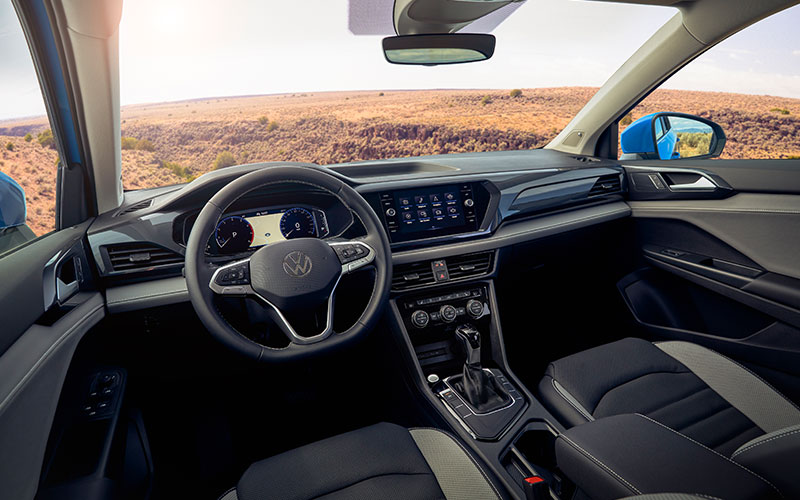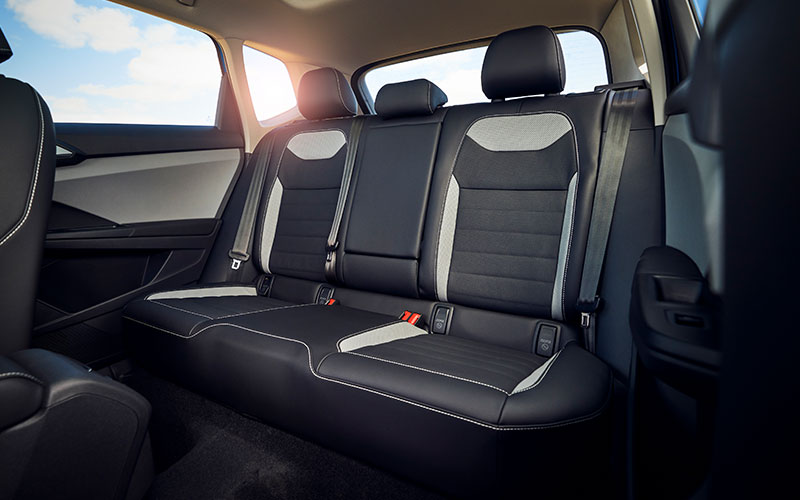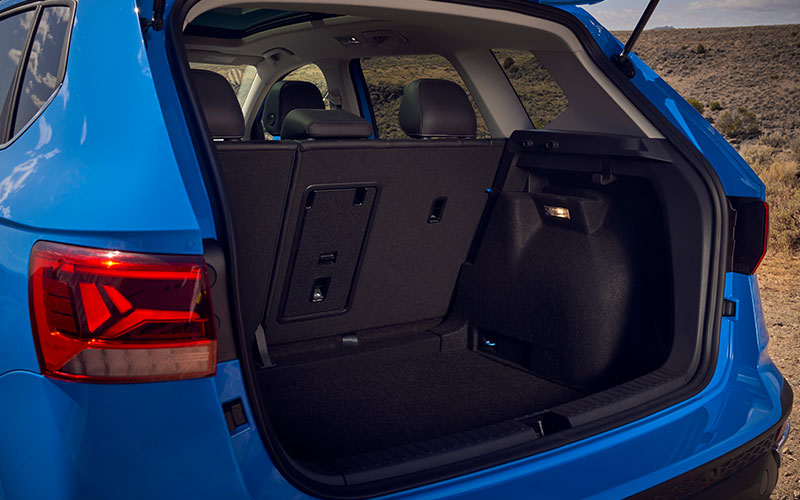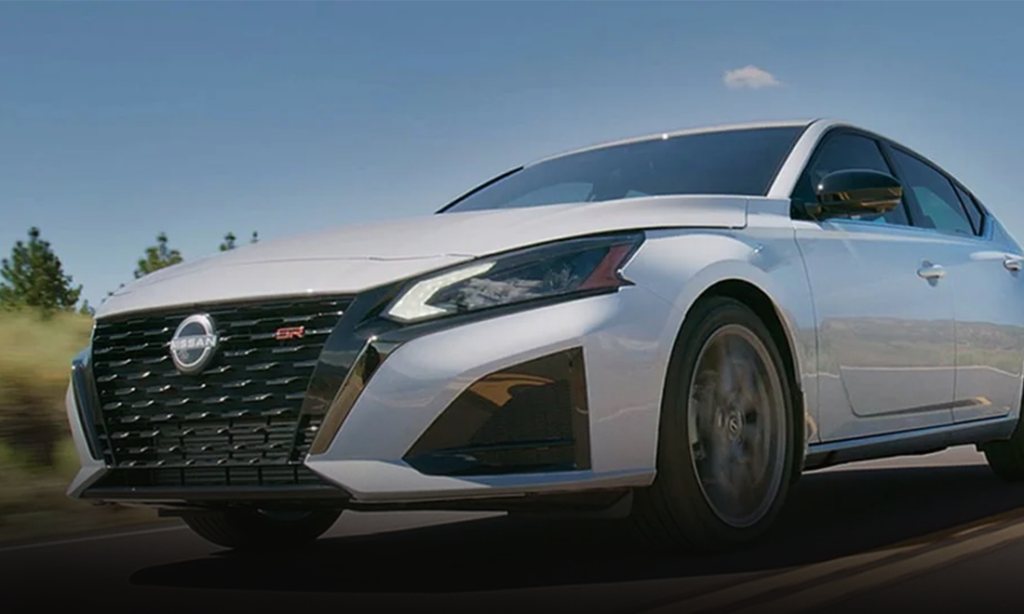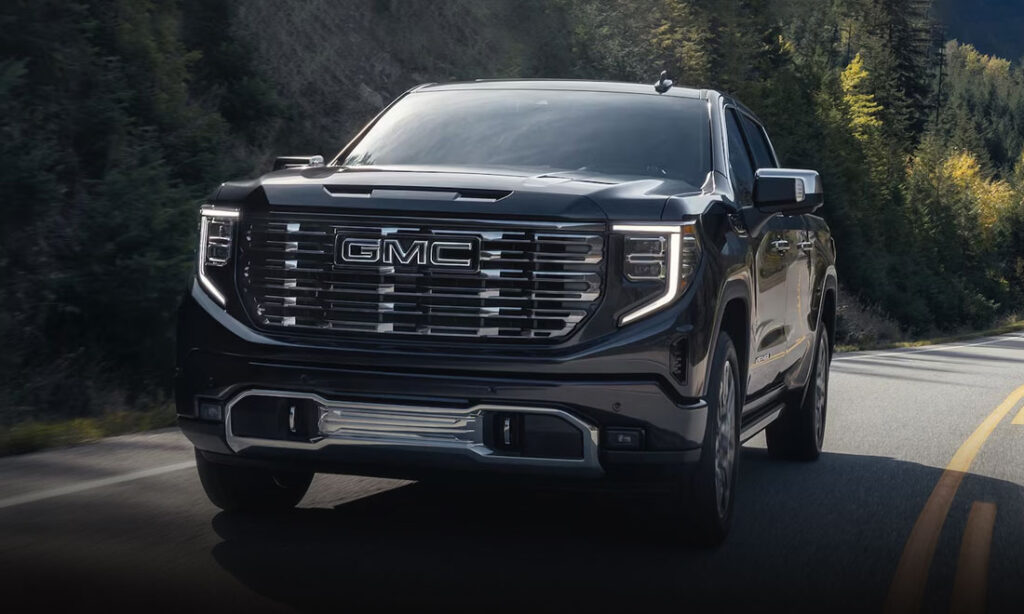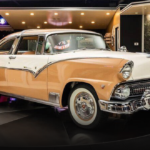2022 Volkswagen Taos Review
The 2022 Volkswagen Taos replaces the Golf and signals that VW is all-in. But does it carry the spirit of the Golf? Let’s find out.
What’s New for the 2022 Volkswagen Taos
What’s new with the 2022 Volkswagen Taos? Everything. As much as we struggle with the Taos replacing the Golf, the hard truth is VW has found its stride in producing SUVs. For the first quarter of 2021, a massive 65% of Volkswagen vehicle sales were from people buying the Tiguan, Atlas, and Atlas Cross Sport.
As enthusiasts, we can sound like a Mitsubishi owner complaining about the absence of an EVO, but big sales speak loudly. Manufacturers won’t spend millions to produce a car that no one buys. So, since the Golf has been losing sales, VW cut the blood loss with the all-new 2022 Volkswagen Taos to add to its SUV garage.
But is that a bad thing? Can the 5-door Taos make you forget the 5-door Golf? Let’s find out.
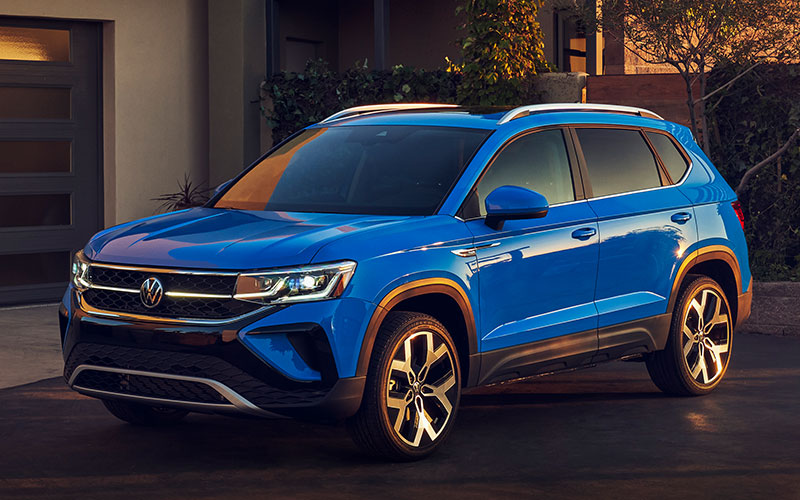
2022 Volkswagen Taos – media.vw.com | Shop 2022 Volkswagen Taos on Carsforsale.com
The Breakdown
The exterior is handsome
Impressive safety technology
Build quality is solid
We like the back seat room
We would love it to be less expensive
2022 Volkswagen Taos Specs
-
- 1.5L turbocharged four-cylinder
- 158 horsepower from base engine
- 184 lb-ft of torque from base engine
- 8-speed automatic
- 6 available trims
- 66 cu-ft. cargo behind first row
- 28 cu-ft. cargo behind second row
2022 Volkswagen Taos Powertrain

New this year is VWs 1.5-liter with its variable geometry turbocharger. VW says that the VTG (variable turbine geometry) is the first volume-production VTG turbo in North America. In non-engineering speak, the turbo gives you a greater boost, better response, and less lag. When paired with the seven-speed dual-clutch transmission, you’ll appreciate the acceleration, but it runs out of steam when pushed to pass on the highway. We didn’t do a 0-60 run, but the Taos felt more than capable of 7-8 second times.
Although extremely quiet and vibration-free at idle, the 1.5-liter gets noisy during acceleration. The engine noise is particularly noticeable when compared to the Honda HR-V with its attention to sound deadening. Let’s say it sounds like it’s going faster.
For shifting, you get an extraordinarily smooth eight-speed transmission for the FWD Taos, and the seven-speed DCT comes with the 4Motion system. We’ve always liked VW Group’s seven-speed DCT for its quick shifts and sport mode. As always, downshifts can be harsh in sport mode, but what seemed appropriate for a sports sedan feels a little out of place in the Taos. The DCT in the Taos is sometimes lazy to get off the line but note that it will eventually learn how you drive if you like things quicker. Unfortunately, there isn’t an option for the eight-speed on a 4Motion, nor can you get the DCT on the FWD. So, you get what you get.
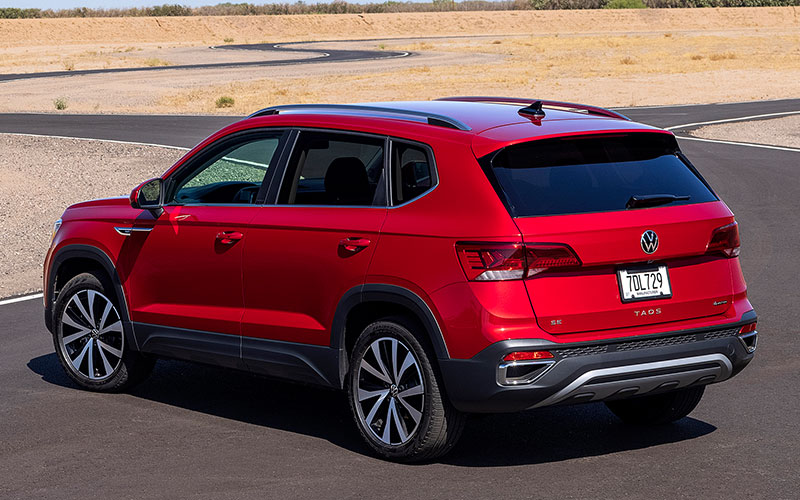
The 4Motion gives you drive mode choices of Normal, Sport, Eco, Individual, Snow, Off-road, and Custom Off-road. Normal and Eco are noticeably more relaxed, with shifts that move more quickly to upper gears when accelerating. Off-road selections also give you a less sensitive throttle, so you don’t go bounding off into the ditch with the standard touchy accelerator pedal. Although not a true off-roader in the Jeep sense, the Taos will do well on dirt or pea gravel roads.
We found the Taos steering to be crazy light in slow speed situations. It was as if there was no weight on wheel at all – like a bad PlayStation steering wheel. Thankfully, changing to Sport mode helped the wheel to feel suitably heavy and more in character with the suspension. The initial stiffness of the suspension goes away on the freeway, where the Taos feels softer and comfortable.
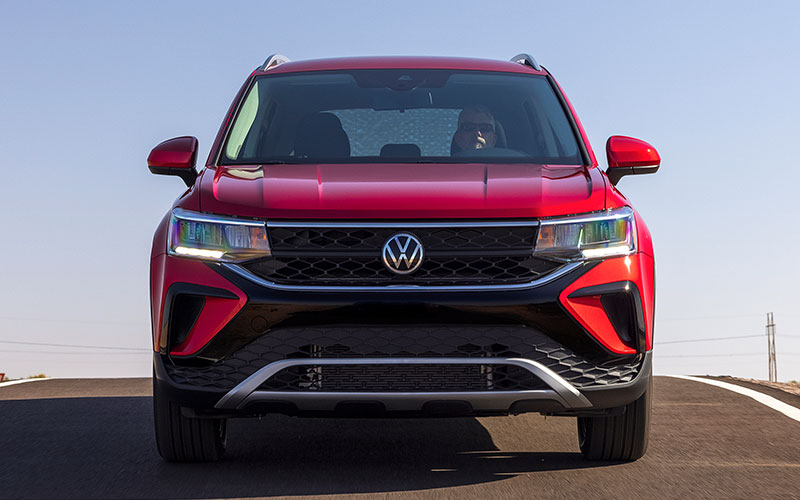
As comfortable as the Taos is in a straight line, it’s less so when it comes to corners. The SEL 4Motion we were driving to lean over and doesn’t feel comfortable in sweeping corners. It’s obvious that the Taos was absent on the day VW was handing out the Golf’s skill set. Granted, it’s an SUV, but we expected more – after all, it replaced the Golf.
Initially there was some handling skill promise when looking at the spec sheet. Just as with the transmission selections, the FWD and 4Motion get different suspensions. For the FWD, VW offers a standard torsion-beam rear axle setup. In the 4Motion trim, the Taos rides on a multi-link rear suspension. Although we didn’t get to try both, other reviewers have made the point that neither outshines the other. We did feel the 4Motion did a decent job keeping everything in line with the front-end, eventually understeered when pushed hard but that’s because of the AWD and not the suspension. True to its SUV purpose, the handling is tuned for comfort and not for sport. Maybe 2023 will bring a more capable sport-mode version.
Towing & Payload
We would love to say that the Taos can tow up to 1000-1500 pounds, but VW doesn’t provide that information. However, we did discover that the payload capacity is 937 pounds so that you can haul a few things with a passenger. If you need to tow a small trailer or your off-road toys, we suggest looking for another model.
2022 Volkswagen Taos Fuel Economy & MPG
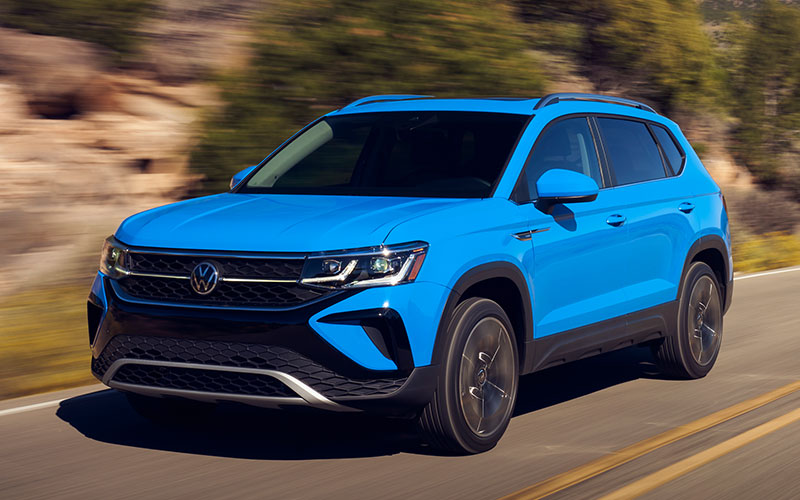
With the four-cylinder turbo, as long as you keep your foot from digging deep, the EPA says the Taos gives you 28 mpg in city driving and 36 mpg while driving a more constant speed.
Interior, Comfort, & Cargo Space
With a wheelbase similar to the Tiguan, the Taos has a surprising amount of room inside. The rear seat, in particular with its legroom, seems to fit in a much larger vehicle. And you’ll be able to fill the space behind the seat with 27.9 cu.ft. of stuff which is four more cubes than an HR-V has.
And about the interior, Volkswagen has been doing an excellent job upgrading its material and design quality across its vehicle line. In this case, with its attention to detail, technology, and solidity, the ultra-modern interior significantly elevates the look of the base model S. In addition, VW lightens the interior with two-tone accents, and it generally works.
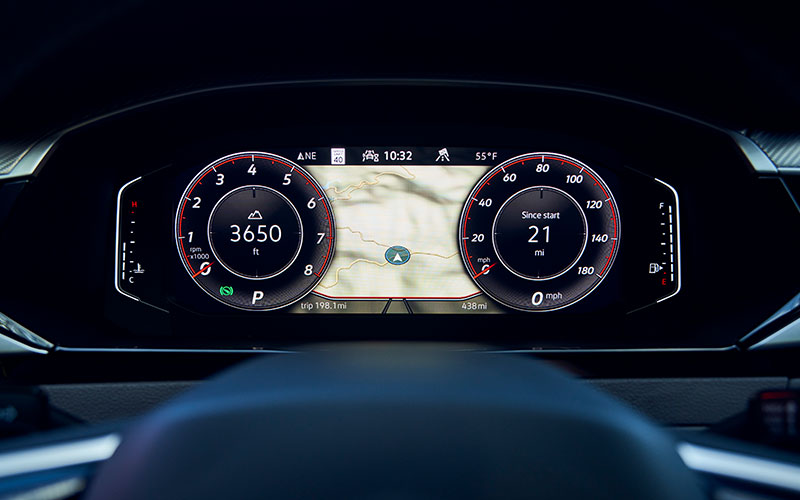
The seats will hold you in place with their prominent side-bolsters, and they’re comfortable in a properly supportive way. The Taos SEL we drove, with its leather seats, had a Mercedes and Audi quality about it – especially with VWs digital dash. The SE gets a new 8-inch instrument panel with the SEL receiving VW’s current 10.25-inch dash. We liked both of them but would note that the new 8-inch version doesn’t have a normal tach. Instead, it’s a ribbon-type dash tach that is easy to read, although unconventional. So, it’s not necessarily better or worse, but worth checking out to see if you like it.
2022 Volkswagen Taos Entertainment & Technology
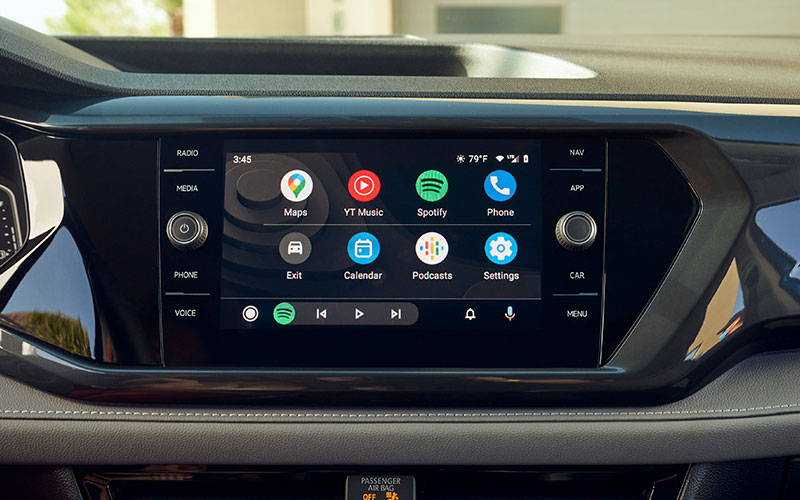
The VW Taos infotainment system is well thought out. With the S, you get a 6.5-inch touchscreen that has the previous version of VWs MIB3 software. The S trims MIB2 system will respond well for your needs but doesn’t have wireless Apple CarPlay and Android Auto. Otherwise, the user interface will be the same. The 8.0-inch touchscreen on the SEL is bright, responsive, and quick to learn. Props, also, to VW for the lighted USB connectors. Every trim comes with multiple connectors, but the SE and SEL USB connectors have charging capability. For the SEL, you get the Beats eight-speaker audio system that has crisp sound and power.
Safety Features
VW’s IQ Drive system is on par with Nissan‘s excellent Pro Pilot Assist. In addition, IQ Drive has a similar semi-autonomous, partially hands-free driving system called Travel Assist. It includes adaptive cruise control, lane-keeping assist, blind-spot, rear cross-traffic alerts, and Emergency Assist, which contacts first responders if you have an accident.
As long as you purchase an SE or SEL, you’ll have some driver-assist protection. But even then, to get the IQ suite that’s standard on the top-of-the-line and expensive, SEL, you would have to pay an additional $895 on top of the already pricey, for its category, SE. It’s not ideal for VW to only offer their automatic emergency braking to those who have the money to pay for it. This safety feature is proven to save lives, and manufacturers like Honda include it on every trim. In the past, we’ve mentioned the importance of automakers providing active safety for everyone, regardless of the trim, and many companies are moving towards that. Hopefully, the market will force VW to do the same.
2022 Volkswagen Taos Trims & Pricing

S – starting at $22,995
The base front-wheel-drive Taos comes with VWs tech cloth seats, 17-inch aluminum-alloy wheels, LED daytime running headlights, and roof rails. VW’s Digital Cockpit comes with a 6.5-inch touchscreen, WIFI, a rear-view camera, and a VWs connection app. You’ll also receive a push-button start, two USB-C ports, a four-speaker sound system, and standard Bluetooth.
Unfortunately, the excellent IQ DRIVE is a $995 option, but at least it’s available. Also included for that $995 is the S Convenience Package, which adds rain-sensing wipers, a heated leatherette-wrapped steering wheel, and a leather-trimmed shifter.

SE – starting at $27,245
The Taos SE comes standard with Forward Collision Warning with Autonomous Braking and Blind Spot Monitoring, but if you want IQ Drive, you’ll pay an extra $895. The technology continues on the inside with VWs latest MIB3 infotainment operating system running on a larger 8-inch touchscreen. Decent sound comes from the Beats audio system’s six speakers and wireless Apple CarPlay and Android Auto. In addition, the seat fabric is upgraded with VWs leatherette and cloth combination, an 8-way power driver’s seat, and privacy glass.
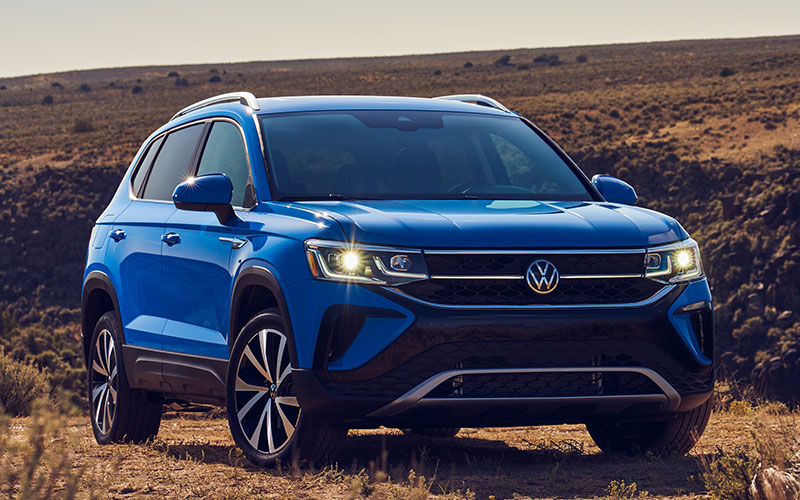
SEL- starting at $31,490
For big money, you get the Taos SEL with IQ Drive, LED headlights, with an adaptive front lighting system. Inside, the SEL gets an upgraded 10.25-inch display, heated leather seats, dual-zone climate control, and a heated steering wheel. With the eight-speaker Beats audio system, you get a 10-color ambient lighting system for the interior.
Warranties
Volkswagen’s factory warranty is better than many competitors with its four years or 50,000 miles protection. The corrosion coverage roles out to seven years and 100,000 miles. Currently, VW also provides free manufacturer-recommended maintenance for the first two years or 20,000 miles.
What we think
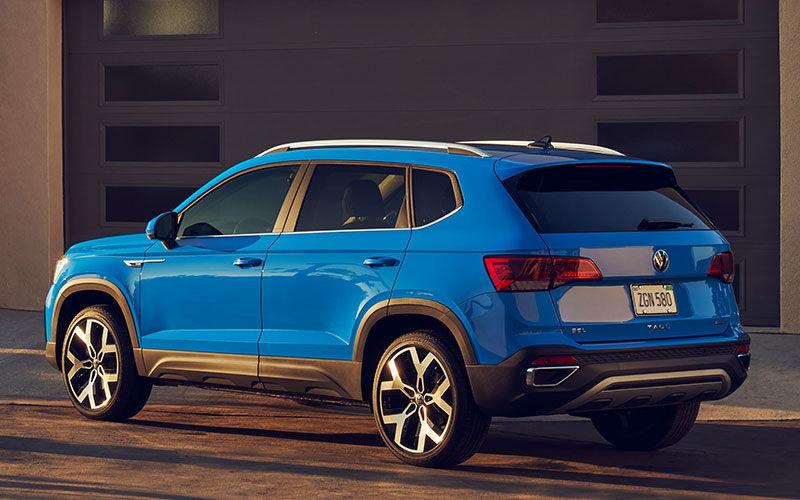
2022 Volkswagen Taos – media.vw.com | Shop 2022 Volkswagen Taos on Carsforsale.com
The 2022 Volkswagen Taos is an exciting and fun addition to the VW SUV line and a great alternative to the Tiguan. Regardless of VW’s intentions, however, it’s not an alternative to a Golf, so enthusiasts won’t find any love. But if you have to get an SUV, this one is well worth checking out. Bring your money.


